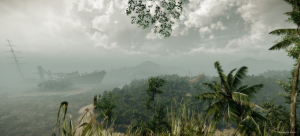In The Island of Dr. Moreau, the three fully human characters exercise their control over Dr. Moreau’s creations with weapons. This control manifests as blind obedience to the Law that Moreau instilled in them. The creatures are made to recite the Law to prove that they understand their subservience to Moreau, and understand how he wishes for them to behave. But neither Moreau nor Montgomery ever attempts to communicate with the creatures without a weapon. When the three men gather the creatures together to find who has broken the Law, Moreau uses a weapon and a commanding tone to enforce the Law: as he makes them recite the Law, he stops them at the point that forbids the consumption of flesh to tell them he knows that this Law has been broken. “’Who is he?’ cried Moreau, and looked round at their faces, cracking his whip” (69). Moreau does not ask the creatures why they let the Law be broken, but instead intimidates them into obeying the Law in the future. The Law is never enforced without the context of a weapon, which makes the obedience of the Law something done out of fear. Even when Moreau is not there, the creatures recite the Law fearfully, “glancing furtively” (45) at one another as they blindly repeat the Law in the presence of Prendick.
After Moreau and Montgomery die, Prendick begins to fear that this will set off a chain reaction: “They know now that we of the Whips could be killed, even as they themselves were killed…” (91). The capitalization of “Whip” demonstrates Prendick’s recognition of the power of that object. The whip is what gives him power over these creatures, not the Law. Moreau and Montgomery feared the breaking of the Law against eating flesh because this was a challenge of the Law that gave the creatures the power of violence. Once this Law is broken, the creatures know that violence can be achieved without punishment, and they can even begin to challenge the punisher with this power.
While Prendick tries to assert the same authority that Moreau and Montgomery did, he cannot instill fear of the Law in the creatures after that the enforcers of the Law are gone. The creatures begin to lose their humanity after Moreau and Montgomery die, slowly gaining back their animal instincts and mannerisms. The Law is forgotten after the fear of punishment is gone.
This dynamic can be seen as an allegory for control over human beings. If a group of people is taught obedience through fear of punishment, they will only obey for as long as that fear is legitimate. As soon as they don’t feel threatened, they will disregard the pretense that they hold any reverence for the law. In order to maintain control, the people must have a real belief in the value of law.
H.G. Wells could have meant for this allegory to represent the work of Christian missionaries to convert natives of colonized lands in the 18th and 19th centuries. The methods of these missionaries often involved the use of forceful indoctrination, threatening natives with punishment if they did not participate in Christian rituals. But the natives continued to practice their own beliefs in secret, demonstrating that, at the very least, they didn’t view Christian law as the sole true law. Wells wanted to show that these methods were futile; any “uncivilized” people will only follow a new law out of fear. But the beliefs behind these laws hold no value to them, and once freed from fear of consequence, they will revert to their old ways.

